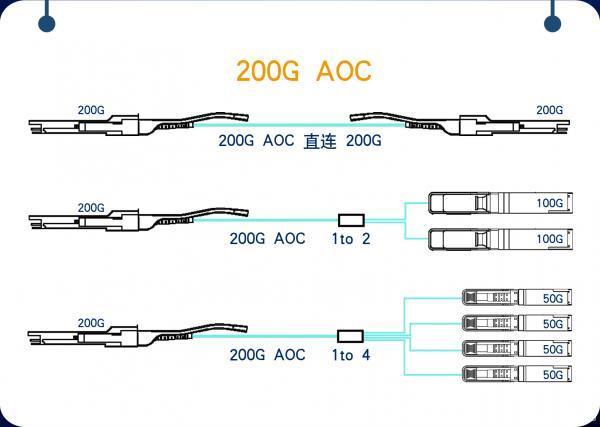200G AOC active optical cable overview
The rapid development of data centers has increased user demand. In order to meet the needs of users, the transmission rate of optical communication transmission has also increased and developed, from the previous 10G and 25G to today’s 100G, 200G and so on. Facing the high-speed, high-density, low-cost, and low-power requirements of optical interconnect products in short-distance data centers, AOC active optical cables provide an excellent solution.

200G AOC active optical cable overview
Introduction to 200G AOC
①200G AOC has two kinds of QSFP28-DD AOC and QSFP56 AOC, the wavelength is 850nm, QSFP56 package has four transmitting and receiving ports, but the transmission rate of each channel is up to 56Gbps, and the modulation method is PAM4. The QSFP28-DD package has eight transmitting and receiving ports, each channel has a transmission rate of 28Gbps, and the modulation method is NRZ. 200G AOC is used for 200G Ethernet with a transmission distance of 1-100 meters.
②200G AOC converts to 2x 100G AOC, one end is connected to one 200G optical module and one end is connected to two 100G optical modules, the maximum transmission rate is 212.5Gbps. The power consumption of 200G optical modules is less than 4W, and the power consumption of 100G optical modules is less than 2.5W. Mainly used in data center 200G to 2 100G Ethernet branch links.
③200G AOC to 4x 50G AOC adopts 8-channel full-duplex active optical cable, one end is connected to a 200G optical module, and one end is connected to 4 50G modules, the maximum rate is up to 206.25Gbps. 200G power consumption is less than 4W, and the maximum power consumption of each 50G module is less than 1.5W. Mainly used in data center 200G to 4-way 50G Ethernet branch link.
200G AOC working principle
The working principle of AOC is not much different. The electrical signal is input through the A terminal, and the electrical signal is converted into an optical signal of a specific wavelength through an electrical-optical conversion device. The optical signal is modulated and coupled and then input into the transmission optical cable; after the optical signal reaches the B terminal, the photodetector device converts the optical signal After detection, it is amplified, processed, and converted to output the corresponding electrical signal.

